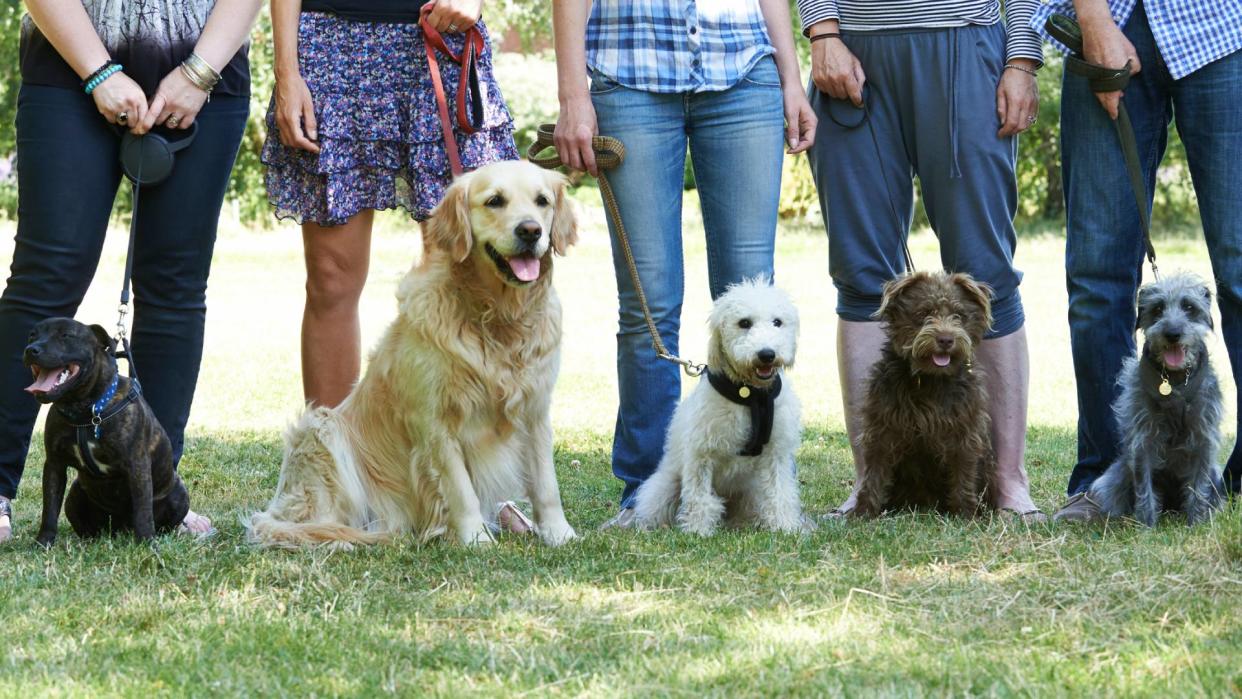Is it easier to train a mixed breed dog or a purebred?

With the rising costs of purchasing a purebred dog, mixed breeds such as cockapoos have become popular with dog lovers worldwide but is it easier to train a mixed breed dog or a purebred? Combining two purebreds isn't necessarily the answer to improving breed health or making a dog easier to train. There are multiple factors to consider, such as a breed's inherent traits.
If you're considering bringing a mixed breed into the home, the most crucial element is understanding the breeds involved in the mix. My first mixed breed dog was Cassie, a whippet/Labrador. It was a perfect cross because the sensible and eager-to-please Labrador traits made Cassie super easy to train with the best dog treats and counteracted the whippet's sighthound traits.
I've shared my life with four pedigree dogs (German Shepherd, Shetland Sheepdog, Doberman and Whippet) and six mixed-breed rescues, and I have worked with a wide range of dogs as a dog behaviorist. Here, I’ll explain the main differences between training mixed breeds and purebreds.
Mixed breed or purebred: which is easier to train?
I rescued Pepper, a mixed-breed dog from Spain. She was only a year old and was a working bird-hunting dog. Pepper is an English Setter/Pointer cross, two breeds with exceptionally high prey drive.
Although Pepper has an adorable temperament, training her has not been without challenges. She cannot go off the lead on open trails because there are hundreds of partridges, pheasants, rabbits, and deer. Even with my skills as a dog behaviorist, her behavior is so hard-wired that her recall is unreliable.
Some breeds live to work. They thrive on learning new things and pleasing their humans. In my experience, working breeds' behavior can turn inwards if their owners do not understand and address the dog's needs.
We may estimate a dog's capacity for training by assessing their intelligence based on human capabilities, but that is inherently wrong. A Behavioral Processes study suggests that a dog's intelligence is not a cognitive process. It is more about how well a dog can physically execute a command. Purebreds, such as Belgian Malinois, German Shepherds, and Dobermans, typically learn fast and keep trying to "get it right" even if they don't understand a command.
Purebreds, such as Huskies, Beagles, Hounds and Atkitas, are the most challenging to train. These breeds often have "attitude" and can be aloof. Their focus is not on pleasing their handler. After all, life has far more exciting things to focus on for these dogs.
So, what happens if you have a German Shepherd crossed with an Akita? Or a Doberman crossed with a husky? Look out! In that case, the most dominant traits will surface. Conversely, a German Shepherd crossed with a Belgian Malinois may have an insane drive to work and is a mixed breed more suited to a working environment than a domestic home.
Mixed breed vs purebred: health
One of the worst aspects of dog breeding is inbreeding. Breeding dogs related through generations can increase the occurrence of harmful genetic health and behavioral traits. For example, Cavalier King Charles Spaniels have high incidences of heart disease. Labradors, German Shepherds and other larger breeds have hip dysplasia issues. Weimaraners are highly emotional, and Hungarian Vizslas are hyper-sensitive and clingy.
Flat-faced breeds like Pugs and Bulldogs have respiratory issues. The length of Dachshunds' spines causes painful problems, and Boxer dogs are prone to cancer. These health issues can reduce the life expectancy of purebred dogs.
Considering the potential health issues with purebred dogs, you may assume that getting a mixed breed dog is a better option. That may not be the case with designer hybrid dogs like Cockapoos (Cocker Spaniel/Poodle), Cavapoos (Cavalier King Charles Spaniel/Poodle) and Puggles (Beagle/Pug). These hybrid breeds command as high a price as purchasing a purebred, and many unscrupulous breeders have jumped on the popular hybrid breeding bandwagon.
Responsible dog breeders focus on selective breeding, meaning they only breed dogs with the best health and behavioral traits. For instance, if a Pug breeder wants to improve breed health, they will match dogs with the least flat noses. However, for some health traits, it can take generations of careful breeding to achieve long-term results.
It's a bit of a lucky dip whether you get a mixed breed or purebred dog that lives a long, healthy life. My oldest purebred, a Doberman, passed at 12.5, and my German Shepherd was 9. My oldest mixed-breed lived a healthy life until she passed at 16.5, and my youngest was 11. My neighbor's purebred working collie passed at 18 years old.
Bigger dogs tend to age faster than small dogs, regardless of whether they're purebred or mixed breeds. Diet, exercise, lifestyle, and veterinary care are other factors to consider for longevity.

Mixed breed vs purebred: personality traits
There's a mixed school of thought about personality traits for mixed-breed dogs. Is it nature or nurture that creates a crossbreed dog's character? If you have a Heinz 57, a next-generation dog bred from other mixed-breed dogs, it's almost impossible to know which personality traits will triumph. It's unlikely you get to meet both of the puppy's parents, so you're not quite sure what to expect when you start training the dog.
Purebred dogs have innate personality traits, making it easier to know what to expect and thus adapt your training strategies. Hounds of all types like to run and chase. Huskies need to move over distance. German Shepherds thrive on working and love training. Whippets hate the cold and getting their paws dirty. Labradors and Springer Spaniels love swimming.
The problem is the overbreeding of purebred dogs for profit. If a breed has innate heart defects, respiratory issues, or exaggerated behavioral traits, making improvements requires a careful breeding plan. Otherwise, health problems can worsen with each litter.
Some of my most challenging behavioral sessions were with purebred dogs. However, to clarify that sweeping statement, in most cases, the problem was a mismatch between the dog and the owner and not a reflection of the breed. Lack of exercise, poor training protocols, and lack of understanding of the breed traits were responsible for most of the problems.
I rarely get called to work with a mixed breed. If I do, it's clear that purebred traits are dominating the behavior. For example, Lurchers are sighthounds, usually a cross between a Greyhound, Whippet, Terrier, Collie or Saluki. The drive to chase is high in all these breeds. A combination often results in training challenges, such as managing the prey drive and establishing a reliable recall.
In my opinion, we must take each dog on its own merit. Learn about the breed traits before bringing the dog home, even if it's a mixed breed. Commit to a breed-specific training program so that your dog is happy to learn and give your dog a safe time out to do what he enjoys.
Looking for more like this? Check out Jan’s other features on how to calm down a hyper dog or how counterconditioning can help your reactive dog.
